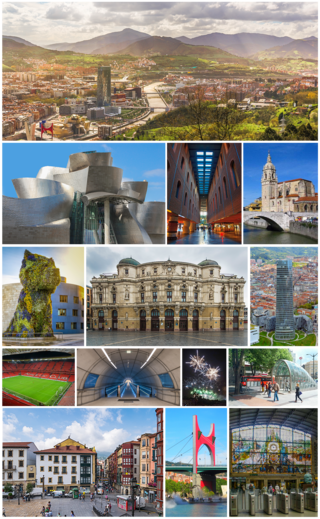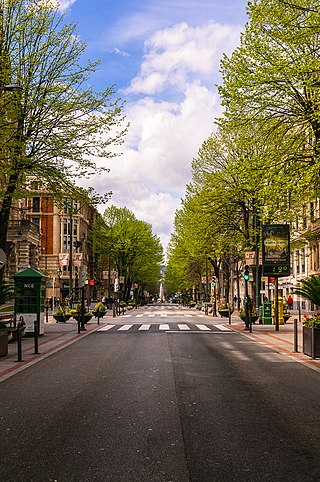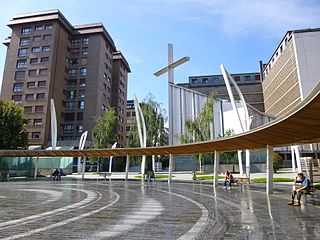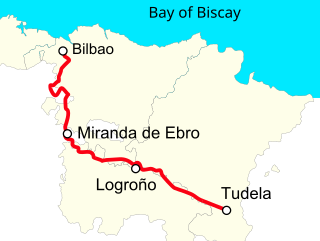
Bilbao is a city in northern Spain, the largest city in the province of Biscay and in the Basque Country as a whole. It is also the largest city proper in northern Spain. Bilbao is the tenth largest city in Spain, with a population of more than 347,000 as of 2023. The Bilbao metropolitan area has 1,037,847 inhabitants, making it the most populous metropolitan area in northern Spain; with a population of 875,552, the comarca of Greater Bilbao is the fifth-largest urban area in Spain. Bilbao is also the main urban area in what is defined as the Greater Basque region.

Postmodern architecture is a style or movement which emerged in the late 1950s as a reaction against the austerity, formality, and lack of variety of modern architecture, particularly in the international style advocated by Philip Johnson and Henry-Russell Hitchcock. The movement was introduced by the architect and urban planner Denise Scott Brown and architectural theorist Robert Venturi in their 1972 book Learning from Las Vegas. The style flourished from the 1980s through the 1990s, particularly in the work of Scott Brown & Venturi, Philip Johnson, Charles Moore and Michael Graves. In the late 1990s, it divided into a multitude of new tendencies, including high-tech architecture, neo-futurism, new classical architecture, and deconstructivism. However, some buildings built after this period are still considered postmodern.

The Bilbao metro is a rapid transit system serving the city of Bilbao and the region of Greater Bilbao. Lines 1 and 2 have a "Y" shape, as they transit both banks of the river Ibaizabal and then combine to form one line that ends in the south of Bilbao. Line 3 has a "V" shape connecting the municipality of Etxebarri with the Bilbao neighbourhood of Matiko; the apex of the "V" is Zazpikaleak/Casco Viejo station, where all three current lines meet. The metro is connected with the Bilbao tram, Bilboko Aldiriak, Euskotren Trena, Feve, Renfe long-distance trains, and Bilbao's bus station. All three lines use metre gauge.

Arata Isozaki was a Japanese architect, urban designer, and theorist from Ōita. He was awarded the Royal Gold Medal in 1986 and the Pritzker Architecture Prize in 2019. He taught at Columbia University, Harvard University, and Yale University.

The Zubizuri, also called the Campo Volantin Bridge or Puente del Campo Volantin, is a tied arch footbridge across the Nervion River in Bilbao, Spain. Designed by architect Santiago Calatrava, the bridge links the Campo Volantin right bank and Uribitarte left bank of the river.

Deusto, also known as Deustu in Basque and formerly known as San Pedro de Deusto, is one of the eight districts of Bilbao, Spain. It is located on the right side of the Bilbao estuary, in the northwestern part of the city and bordering the estuary itself on the south and the southern hillside of Mount Artxanda and Mount Bandera on the north. Deusto was originally an elizate and also a municipality until 1925 when it was completely annexed by Bilbao in order to expand the free land available to the city. Deusto is known as the university district of the city as it is home to the University of Deusto and the Faculty of Economics and Business of the University of the Basque Country.

Bilbao La Vieja in Spanish, "Old Bilbao" in English and Bilbo Zaharra in Basque.

Abando, formerly known as San Vicente de Abando, is one of the eight districts of Bilbao, Basque Country (Spain). It covers most of the city's centre, located on the left bank of the estuary of Bilbao. It is the only district of Bilbao with all of its land completely urbanised. Abando was originally an elizate and also a municipality until 1876, when part of it was annexed to Bilbao, the rest of the elizate's municipal land was integrated into Bilbao in 1890. In 2016 the population was 50,903. Abando is the wealthiest district in Bilbao, with personal and family incomes being well above the citywide average.

Cercanías Bilbao is a commuter rail network in Bilbao, serving the city and its metropolitan area. It is operated by Cercanías, as part of Renfe, the national railway company. It consists of three lines, named C-1, C-2 and C-3. All three of them start at Bilbao-Abando station, which is the central station of the city.

Indautxu is a quarter of central Bilbao, Basque Country (Spain), located in the district of Abando. It is a relatively affluent neighbourhood and is most famous for the large number of private hospitals and clinics, the large Society of Jesus school and the Doña Casilda Iturrizar park, all located in the area.

The BilbaoCity Hall is the seat of the Bilbao City Council, the local ayuntamiento of Bilbao, Spain. The City Hall is located on the right bank of the Estuary of Bilbao across the Puente del Ayuntamiento bascule bridge that links it to the central Abando district.

The Euskalduna Conference Centre and Concert Hall or Euskalduna Palace or Euskalduna Hall is located in the city of Bilbao, Basque Country (Spain), beside the Estuary of Bilbao, built in part of the area that was formerly occupied by the Euskalduna shipyards.

The Abando Indalecio Prieto railway station, usually known simply as Bilbao-Abando and previously known as Estación del Norte is a terminal railway station in Bilbao, Basque Country (Spain). The name comes from Abando, the district in which the station is located, and Indalecio Prieto, who was Minister of Public Works during the Second Spanish Republic. The station serves as the terminus station for several long and medium distance services operated by Renfe as well as commuter rail services within the Bilbao metropolitan area operated by Cercanías. The station has direct access to Metro Bilbao and to the tram, as well as many local and regional bus lines. The railway station Bilbao-Concordia, operated by Renfe Feve is located in close proximity. After the construction of the high-speed line Basque Y is finished, Bilbao-Abando will serve as the western terminus, which will involve the creation of a completely new station replacing the current one.

The Isozaki Atea twin towers in Bilbao, Spain are the tallest residential buildings in the city and the Basque Country, designed by Japanese architect Arata Isozaki. The towers are 83 metres (272 ft) tall and have 23 floors. The first two floors are used for mixed-commercial purposes, and the remaining floors are residential. The towers are part of a five-building complex. The other three buildings' heights range between six and eight floors.

The Iberdrola Tower is an office skyscraper in Bilbao, Spain. Its construction started on 19 March 2009 and was officially inaugurated by King Juan Carlos I on 21 February 2012. The tower has a height of 165 metres (541 feet) tall and has 40 floors. The first eight floors of the tower were to hold a hotel by the Spanish hotel chain ABBA, but the project was eventually cancelled. The tower, built as Iberdrola's headquarters, is the tallest building in the Basque Country and the city of Bilbao, and the ninth tallest building in Spain.

The Gran Vía de Don Diego López de Haro is the main avenue of the city of Bilbao, Basque Country (Spain).

The Bilbao-Concordia railway station, also known as La Concordia Station, and formerly and colloquially known as Santander Station, is a terminal railway station in Bilbao, Basque Country (Spain). The station was opened in 1902 and currently serves as the terminus station for several narrow-gauge regional and metropolitan railway services operated by Renfe Feve, a division of the state-owned Spanish railway company Renfe. The Bilbao-Abando railway station, also operated by Renfe and that offers medium and long-distance services is located in close proximity.

The Tudela–Bilbao railway is a Spanish railway from Casetas to Bilbao.

Chris Dyson is an English architect. He established Chris Dyson Architects. in 2003. He is known for residential conservation architecture.

Abando is a station on lines 1 and 2 of the Bilbao metro. The station is located in the neighborhood of Abando, in the district with the same name. The station is located close to Bilbao-Abando railway station, to which it is directly connected. It opened on 11 November 1995. It is one of the busiest stations in the network.





















